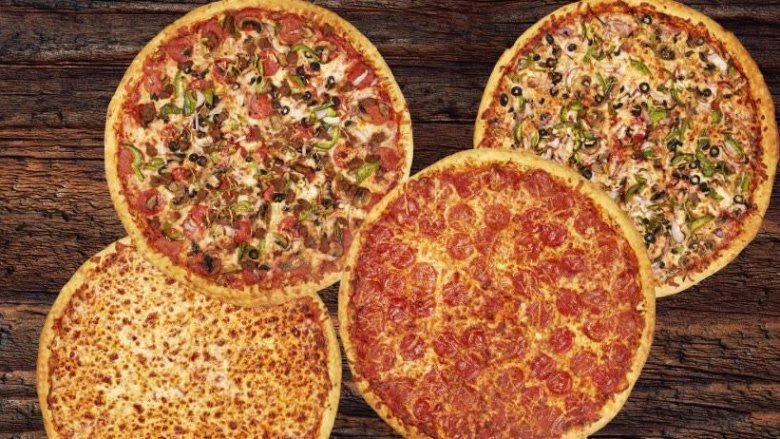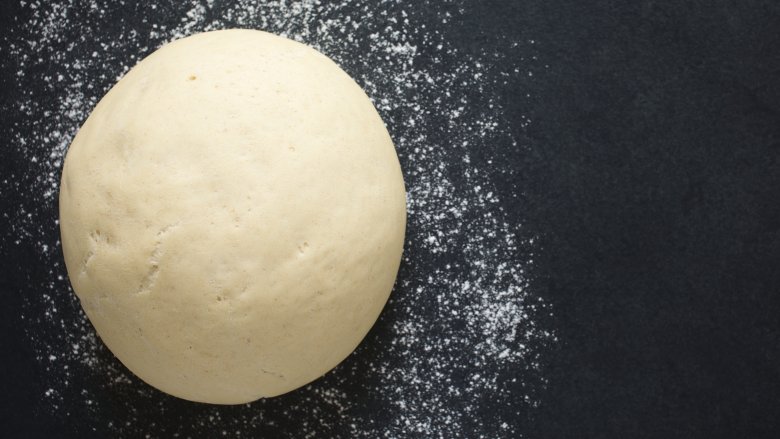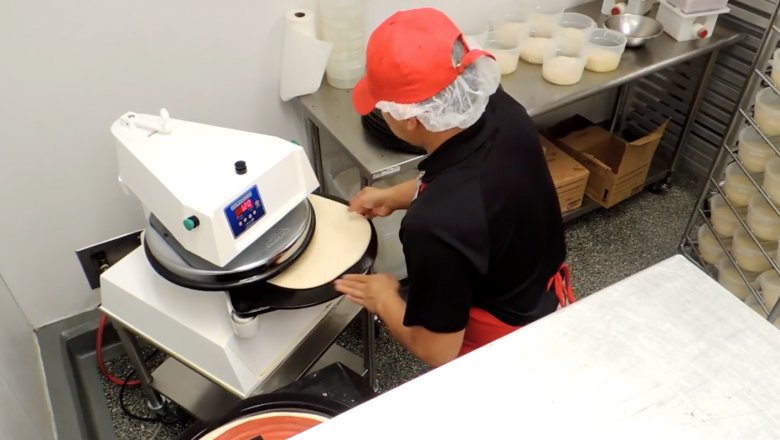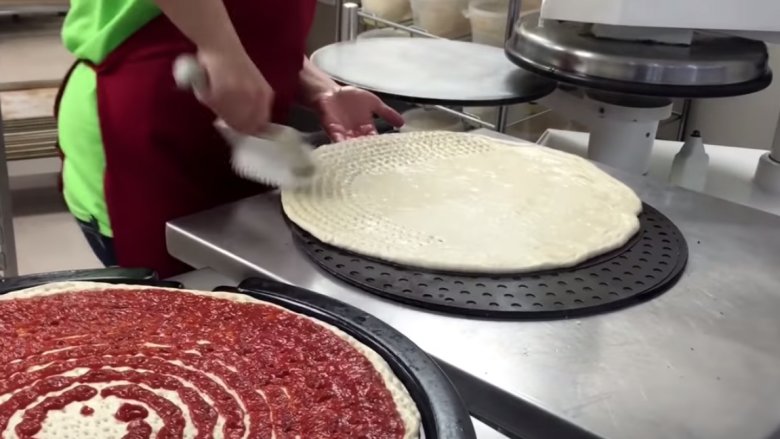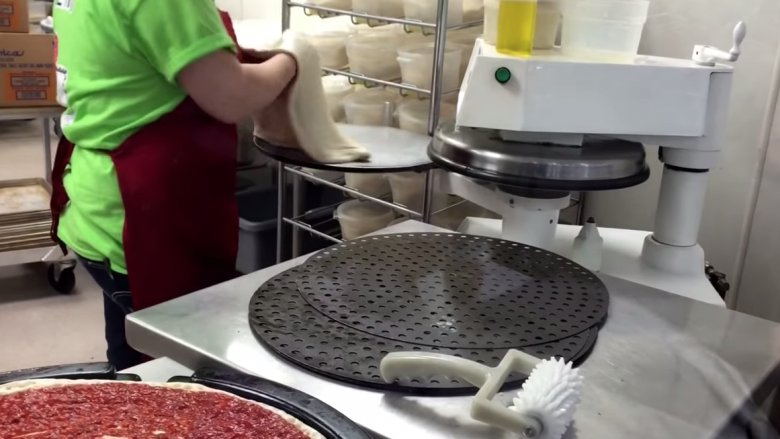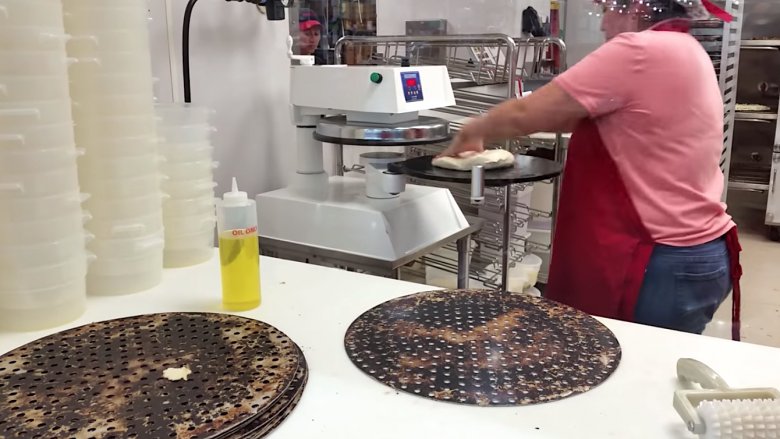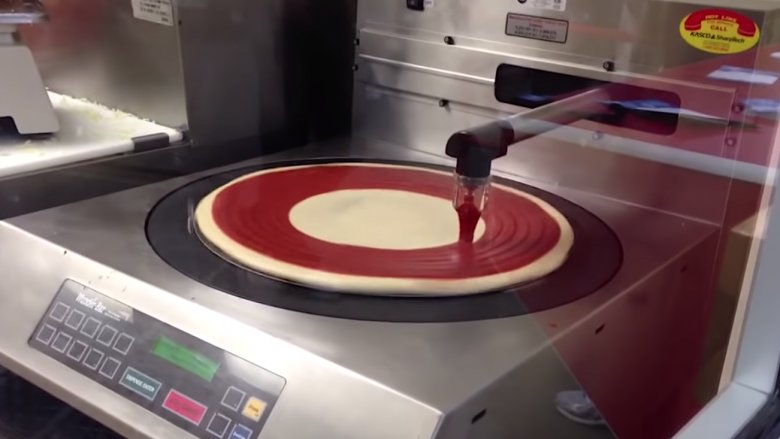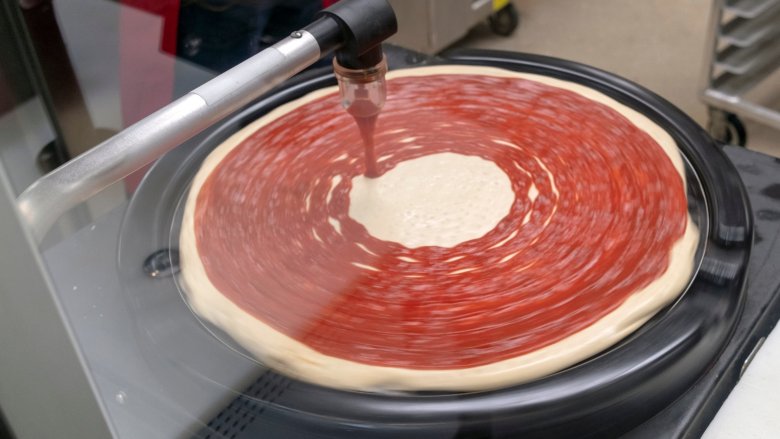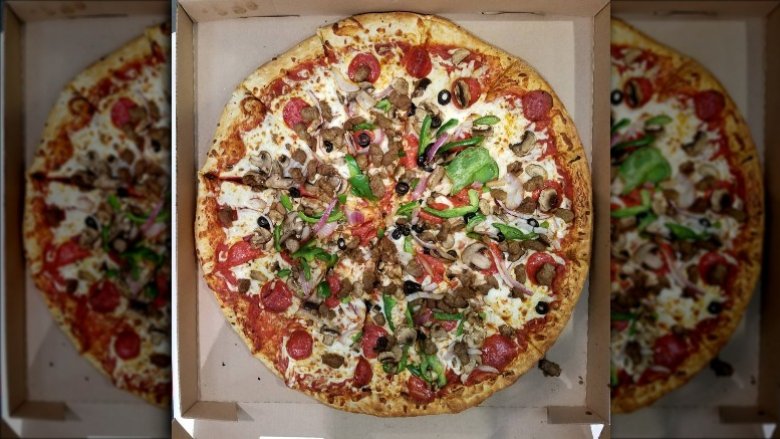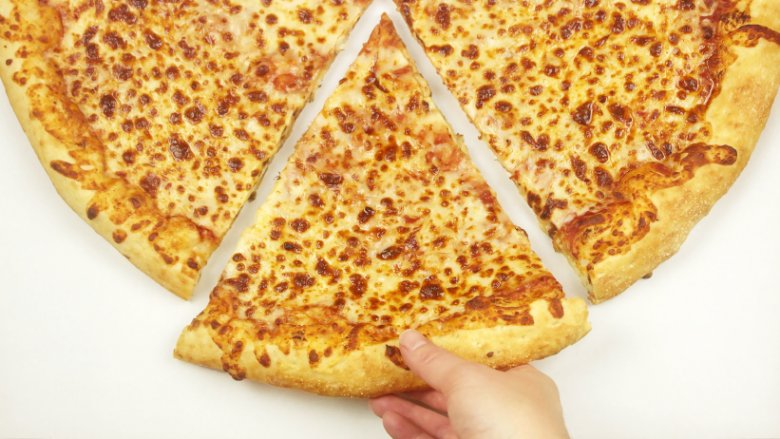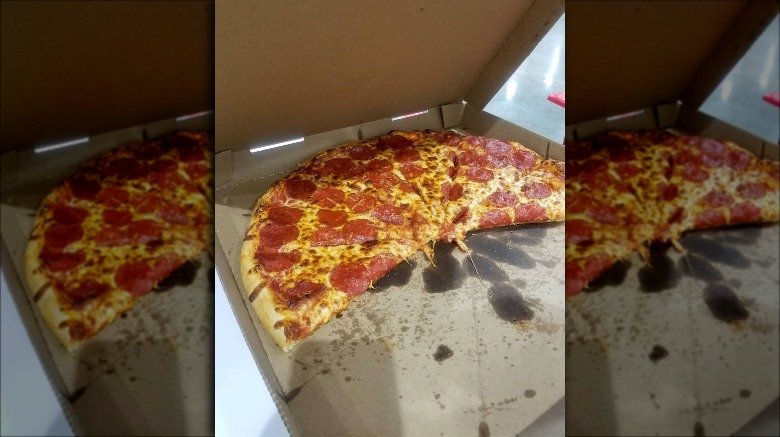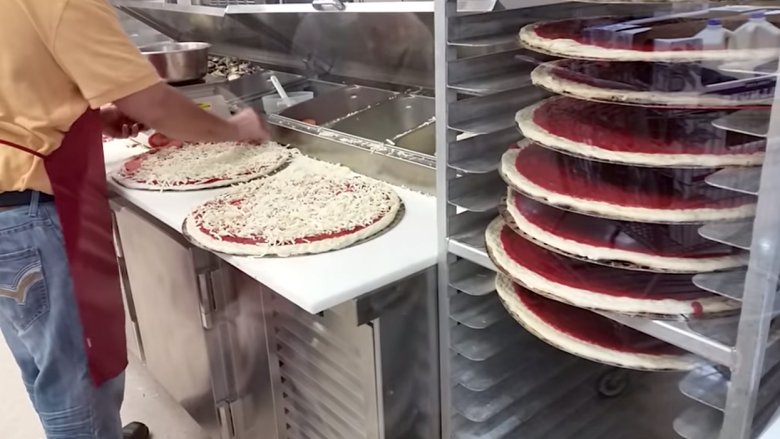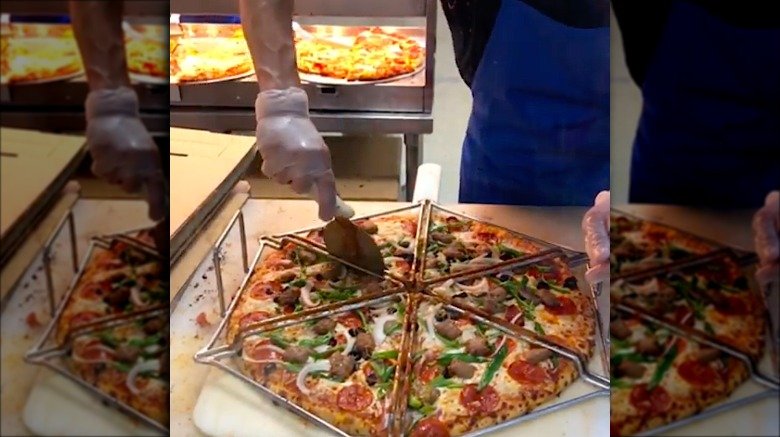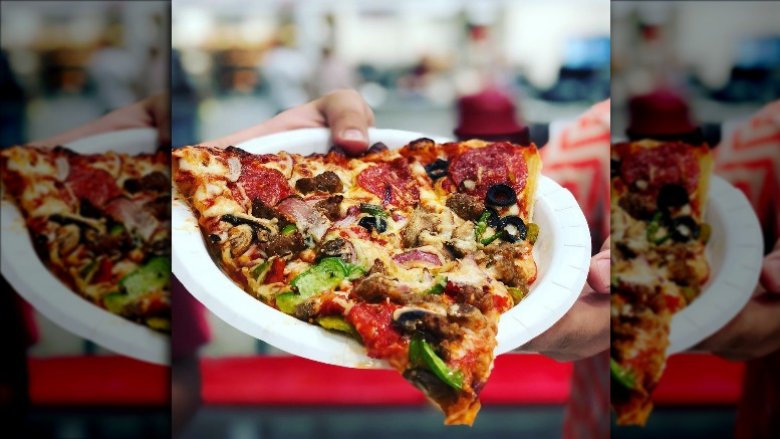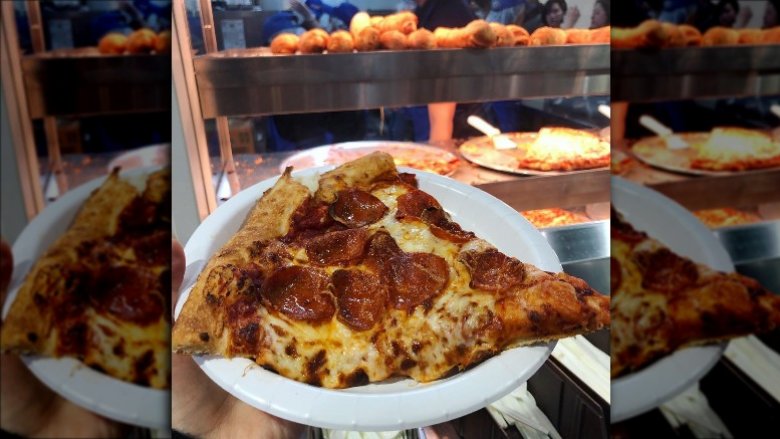How Costco Pizza Is Really Made
There are plenty of very good reasons to go to Costco — too many to list, as a matter of fact. You know that when a store offers literal buckets of mac and cheese it's a place you should definitely be shopping. But there's also the food court to consider, which should be at the very top of your list of reasons to frequent the warehouse store.
While most everything the Costco food court sells is utterly delicious, and though they're arguably most famous for their $1.50 hot dog and soda combo, it's their pizza that's tops. Somehow, someway, a store known for bargain-priced bulk toilet paper and $5 rotisserie chickens has managed to make pizza that's tastier than actual pizzerias.
How do they do it? Turns out, aside from copious amount of cheese and toppings, the Costco food court employs not only humans, but robots, too, to crank out their oh-so-tasty pies. Starting from an unassuming ball of dough, and ending with that ginormous finished product, here's exactly how Costco pizza is made.
It starts with great dough
All pizza has to start with great dough, right? But most of us can think back to a visit to the so-called best pizzeria in the neighborhood, only to be disappointed by the crust. Sometimes it's too thick, sometimes it's too thin, sometimes it's too doughy, sometimes it's too crispy. Basically, if you're Goldilocks, the Costco food court is the place for you because their crust is just right.
According to Thrillist, Costco purchases their dough from a New York distributor — Brooklyn-based to be exact — who delivers the dough daily. So not only do you know it's super fresh, you also know it's legit (if you're a fan of New York-style pizza, anyway — fans of deep dish Chicago-style, maybe keep moving). Once the warehouse stores get the dough, it's rested and proofed, and Kaiwen Zhao, a supervisor at Costco, explained in a Quora thread that taking the time with those steps is a big part of the pizza's overall success. "We spend a lot of time on dough management, it normally takes 24–27 hours for a dough to be ready to press," he said.
There's a dough squisher
After the dough is lovingly tended to for a day, it's time to head to what we like to call the dough squisher (which is surely its technical name). This contraption takes a ball of already-made dough, and in seconds transforms it into a perfect pizza crust.
What's the big deal? Well, for starters, it takes the potential opportunity to mishandle the dough out of the equation, which almost guarantees a better, tastier crust — when a machine is doing the work for you, there are no variables. But this squishing device doesn't just flatten the pizza dough with sheer force, it actually uses some heat to get the job done. According to Thrillist, the plates flatten the dough for seven seconds under 130 degrees of heat. This minimal but effective temperature guarantees the dough is squished into submission, and means it will be the just-right thickness every time.
The dough docker is an important tool
Once the pizza dough is placed onto the pan, it's minimally handled but still needs to be stretched to fit. So far, this is pretty standard in the pizza-making biz, right? But at this point, a Costco food court employee will take one more very important step (with the help of a specialty tool) to ensure the finished product is nice and flat, and not full of giant air bubbles that disrupt the crucial sauce to cheese to crust ratio.
The tool is called a dough docker, and it's vital to making the Costco pizza we all know and love. It's a medieval-looking spiked roller, and the contraption gets rolled across and around the pizza dough, leaving indentations everywhere it touches, and more importantly, popping any air bubbles that linger. Once those offensive bubbles are eliminated, the crust is free to bake more evenly. Skip this step and your Costco slice might have one giant empty air pocket in the middle, which, needless to say, is not optimal.
The kind of pan is crucial
Okay, let's recap: So far we know that the dough itself, the dough squisher, and the dough docker are all of utmost importance in the Costco pizza-making process. But there's one more dough-centric piece of the puzzle that makes the warehouse store's pies what they are, and that's the pizza pan itself. You can love and massage pizza dough all you want, but the kind of pan you cook that pie in matters.
Costco uses pizza pans with holes, otherwise known as perforated pans, and these holes allow the crust to bake up crispier thanks to two things: 1. Rather than solid metal grabbing all the heat, the holes ensure that it transfers directly to the crust. 2. The holes allow moisture to escape out the bottom, rather than sog up the crust, and lets the entire thing cook evenly. And, as an added bonus, pizzas baked on perforated pans cook faster.
As a contrast, solid pans would produce a pizza with a chewier crust than those baked on perforated pans, and they might even prevent the toppings from cooking properly thanks to uneven heat distribution.
But they might not get washed very often
It's hard to find much wrong in Costco's streamlined pizza-making process, but if we're to believe everything we read on the internet, the food court's treatment of those pizza pans might give you a little pause.
According to one Redditor who was asked if they would still eat at the food court given all their inside knowledge of any questionable practices, there was one thing that came to mind. "Some people have hangups about the fact that we don't wash our pizza discs every time we use them," they spilled.
Is this really a big deal, though? If you're a carnivore, there's obviously no concern of gross meat juices adulterating your cheese pie, but vegetarians probably won't love the idea. The obvious concern is if you have an allergy to one of the toppings that even a trace amount of could set off. If you're not a vegetarian and you don't have allergies but are in the "it's just gross not to wash pans" camp, think of it like a baking sheet — when you're making cookies, you don't wash the trays in between, do you?
There's a sauce robot
Did you think we were kidding when we said Costco employs robots in their pizza-making process? We weren't. And this automated saucing machine just so happens to be the coolest step in the whole process.
How's it work? Once the pizza dough is squished and docked, the prepared pan gets placed onto the sauce robot by a human food court employee (see, we're still needed). At the push of a button, the contraption spins the pan around and spits out sauce in a very precise stream as its arm moves towards the center of the pie. The result is a kind of spin art effect on the dough, and while it's mesmerizing to watch, the reality is that the robot not only ensures that just the right amount of sauce is on each and every pizza, it also ensures that the right amount of sauce is equally distributed. This means that you're never going to bite into a slice and get a huge mouthful of sauce, nor will you get a dry bite. Win, win.
What's in the sauce?
We may not have Costco's official confirmation of what's in their sauce, but we can assume that a product sold by Costco and called "Costco Pizza Sauce Concentrate" should probably give us a pretty good idea as to its ingredients, right?
According to one shopper who posted to PizzaMaking.com's forum, at one time Costco's pizza sauce was sold in its Business Centers. These ginormous boxes of concentrate contained six 108-ounce packets of sauce, which were each to be mixed with 82 ounces of water for a total of 1,140 ounces of that glorious sauce for just $19.99. But we don't really care about how much it would cost to make it at home, right? We care about what's in the sauce that tops our favorite pizza.
It's pretty basic: tomato puree (tomato paste and water), sugar, citric acid, spices, dehydrated garlic, salt, and spice extractive. The distinct flavor of Costco's pizza sauce clearly comes from some unlisted spices and extractives, but we're not mad at them for keeping it a secret — at $1.99 per slice and $9.95 per pie, it's hard to beat Costco's value, even when you consider the low cost of homemade pizza.
There are a ton of toppings
Even if you've never had the pleasure of enjoying a slice of Costco pizza, which completely dwarfs the paper plate it's served on at the food court, you can tell with just one glance that it's got some serious heft to it. And anyone who's ever hoisted one up will confirm that what you suspected is true: Those slices do indeed weigh a ton.
There's the crust and cheese, of course, but the toppings — especially on the combo variety — are no joke. According to the Costco Connection, the combo pizza comes complete with Italian sausage, pepperoni, and a medley of sliced green bell peppers, red onions, mushrooms, and black olives. Pretty standard, right? But here's where it gets impressive: The finished pizza weighs in at 4.49 pounds.
As for the pepperoni pizza, each pie gets a total of 60 slices, which explains why every single slice is covered edge to edge in that gloriously greasy, perfectly spicy meat.
There's so much cheese
We know that all those toppings account for some of the heft of Costco's pizzas, but if you think that by ordering a plain ol' cheese you'll be short-changed in the toppings department, you couldn't be more wrong — Costco isn't about to leave its cheese-lovers in the dust.
First, let's talk about the kind of cheese that's topping those pies. The Costco Connection describes them as "aged and buttery cheeses (an 80 percent-20 percent blend of low-fat, part-skim-milk mozzarella, and provolone), and 10-month-aged shredded Parmesan." Maybe that doesn't sound so remarkable, but considering other pizza chains like Pizza Hut and Papa John's use just mozzarella, that combination in and of itself should set Costco apart.
But it's the amount of those cheeses that Costco uses on its cheese pie that will blow your mind: One pizza contains a whopping 24 ounces of the mozzarella-provolone blend. That's right — one-and-a-half pounds of cheese alone.
And because Costco is committed to maintaining their low, low priced food court items, Thrillist reports that they lock those cheese prices in years in advance, allowing them to avoid price hikes dues to market fluctuations. Smart.
There's some oil involved
If you've ever ordered a whole Costco pie, you've probably noticed something about the bottom of the box once you've finished your last slice: it's a bit oily. Some grease is to be expected with pizza, though, between all the oily cheese and greasy pepperoni. But one in-the-know Redditor expressed concern over just how much oil the Costco food court employees are told to use in the making of the pie.
"The only thing that concerns me is how much oil gets used in the process of making a pizza skin (the stretched out and sauced pizza dough). Too much," they explained. "And when you don't use the corporate requested amount because you think it's too much and corporate notices? You use more oil to avoid being in trouble. Some managers over compensate and use a quarter cup of oil+ when making them."
A 1/4 cup of oil (or more) per crust would definitely explain that bottom-of-the-box phenomenon.
It all happens super fast
When you have things like automatic dough squishers and sauce robots combined with food court employees who mean business in the cheese and topping department, you can guess that Costco's pizza-making process, from start to finish, is pretty darn fast. And it's not just the making of the pizza that's fast, it's the baking, too.
Thanks to curious Costco shoppers looking in on the food court goings-on, we know that all it takes is a little more than 30 seconds for a ball of dough to be turned into a sauced pie, ready to be topped. The toppings portion of the process is also mind-boggling fast, and even a combo, which includes the most ingredients, is ready for the ovens in about 45 seconds thanks to the masterful hands of a longtime food court employee. Finally, it's into the oven they go. Each kind of pizza has its own conveyor oven set for exactly the right time for the specific pie, and Costco supervisor Kaiwen Zhao says that happens in under six minutes.
What we're saying here is that Costco is cranking out these pizzas in well under eight minutes. That's impressive.
They're precisely cut every time
One thing you never have to worry about when you grab a slice from the Costco food court is that you're going to be cheated on the portion, and that's because the food court employees use a handy dandy cutting guide that ensures every slice is exactly the same size. Considering each pie is absolutely massive, you know that after the cutting is done, you're also going to be getting a massive slice — one sixth of an 18-inch pizza, to be exact.
Now, if you order a whole pizza the workers will cut through the guides once, then rotate it to cut those slices in half again, and in this case, each slice may not be quite so even. But hey, you've got a whole pie to work with.
Just more proof that Costco has every aspect of the pizza-making process down to a science — even something as simple as how best to cut it.
It's always fresh
You didn't think Costco would spend all this time and energy perfecting each step of their pizza process only to let it all fall apart by serving less-than-fresh pies, did you? No way.
When a curious Redditor asked the masses if Costco reheats the previous day's leftover pizza for the earliest customers to eat (because who doesn't want pizza for breakfast?), another in-the-know Redditor answered, "Nope, everything left over is tossed after we roll the door at night, and made fresh in the morning." What's more, Costco supervisor Kaiwen Zhao explained in a Quora thread that the pizza isn't even a few hours old. "Any pizza slice that doesn't sell within the hour gets thrown out and replaced to maintain freshness," he said.
Really, if we're being honest, we think this one-hour rule was probably just put in place so employees would get to use that awesome sauce robot more often.
Why does a slice taste better than a whole pie?
Now that we know the ins and outs of Costco's wondrous pizza-making process, there still one question that needs answering: If the slices are just the same as the whole pies, why do they taste so much better?
Obviously the size makes some difference — a slice is about twice as big as a slice from the whole pizza, but that doesn't actually make it taste better, we just like the idea of having more. So what gives?
As always in situations like these, we turned to Reddit, and the answer is really quite simple: The moisture that gets retained inside the box of the whole pizza tends to soggy up the whole situation. Additionally, Redditors surmised that the slices benefit from sitting under the heat lamps of the food court window, getting a little crispier than their boxed counterparts.
Knowing Costco, it probably won't be long until they patent some amazing moisture-evaporating pizza box to add to their already amazing pizza operation.
